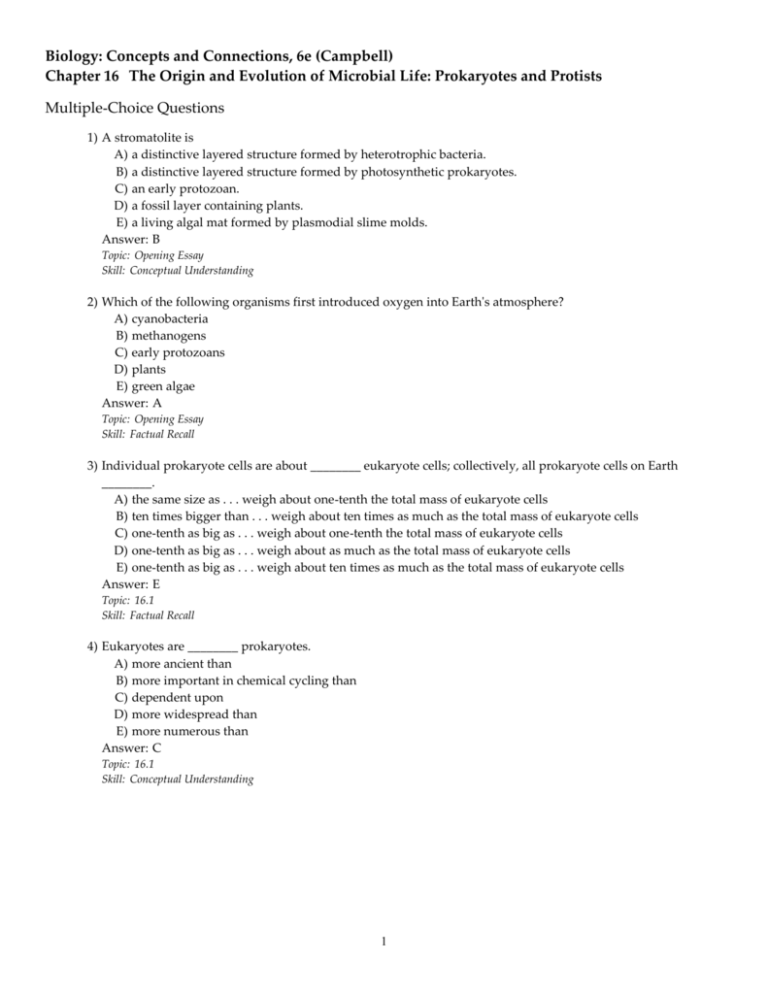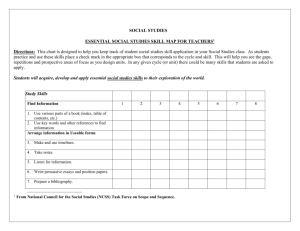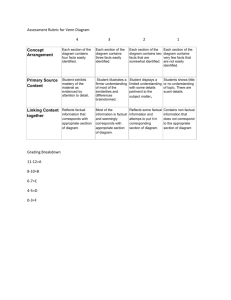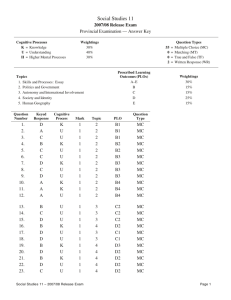Biology: Concepts and Connections, 6e (Campbell)
advertisement

Biology: Concepts and Connections, 6e (Campbell) Chapter 16 The Origin and Evolution of Microbial Life: Prokaryotes and Protists Multiple-Choice Questions 1) A stromatolite is A) a distinctive layered structure formed by heterotrophic bacteria. B) a distinctive layered structure formed by photosynthetic prokaryotes. C) an early protozoan. D) a fossil layer containing plants. E) a living algal mat formed by plasmodial slime molds. Answer: B Topic: Opening Essay Skill: Conceptual Understanding 2) Which of the following organisms first introduced oxygen into Earth's atmosphere? A) cyanobacteria B) methanogens C) early protozoans D) plants E) green algae Answer: A Topic: Opening Essay Skill: Factual Recall 3) Individual prokaryote cells are about ________ eukaryote cells; collectively, all prokaryote cells on Earth ________. A) the same size as . . . weigh about one-tenth the total mass of eukaryote cells B) ten times bigger than . . . weigh about ten times as much as the total mass of eukaryote cells C) one-tenth as big as . . . weigh about one-tenth the total mass of eukaryote cells D) one-tenth as big as . . . weigh about as much as the total mass of eukaryote cells E) one-tenth as big as . . . weigh about ten times as much as the total mass of eukaryote cells Answer: E Topic: 16.1 Skill: Factual Recall 4) Eukaryotes are ________ prokaryotes. A) more ancient than B) more important in chemical cycling than C) dependent upon D) more widespread than E) more numerous than Answer: C Topic: 16.1 Skill: Conceptual Understanding 1 5) Prokaryotes are classified into A) domain Monera and domain Archaea. B) kingdom Bacteria and kingdom Archaea. C) domain Bacteria and domain Archaea. D) kingdom Protista and kingdom Monera. E) domain Bacteria and domain Monera. Answer: C Topic: 16.2 Skill: Factual Recall 6) Evidence for the relatively close relationship of archaea to eukaryotes includes A) the absence of ribosomes in both of these groups. B) the absence of introns from genes in both groups. C) the fact that both contain circular DNA without histones. D) the presence of peptidoglycan in the cell walls of both groups. E) the fact that their growth is not inhibited by certain antibiotics that inhibit bacterial growth. Answer: E Topic: 16.2 Skill: Factual Recall 7) Unlike archaean and eukaryote cell walls, bacterial cell walls contain a unique substance called A) cellulose. B) peptidoglycan. C) phospholipid. D) glycogen. E) proteinoid. Answer: B Topic: 16.2 Skill: Factual Recall 8) Pairs of rod-shaped bacteria are called A) cocci. B) bacilli. C) diplobacilli. D) spirochetes. E) vibrios. Answer: C Topic: 16.3 Skill: Factual Recall 9) Curved bacterial cells that are shaped like commas are called A) cocci. B) bacilli. C) diplobacilli. D) spirochetes. E) vibrios. Answer: E Topic: 16.3 Skill: Factual Recall 2 10) Prokaryotic cell walls function A) as a site for phagocytosis. B) to promote flexibility and formation of pseudopodia. C) to prevent the cell from bursting in a hypotonic environment. D) to propel cells (locomotion). E) as a site of metabolic reactions (photosynthesis and cellular respiration). Answer: C Topic: 16.4 Skill: Factual Recall 11) An unknown bacterial species is recovered from a sick patient's digestive tract. It has a membrane outside the cell wall that contains toxic lipids. This observation indicates A) that the infection should be relatively easy to control with common antibiotics, because the pathogen is a gram-positive species. B) that the infection should be relatively easy to control with common antibiotics, because the pathogen is a gram-negative species. C) that the infection may be quite threatening and difficult to control, because the pathogen is a grampositive species. D) that the infection may be quite threatening and difficult to control, because the pathogen is a gramnegative species. E) that the infective agent forms endospores. Answer: D Topic: 16.4 Skill: Application 12) Which of the following options correctly pairs a structure with its function in prokaryote cells? A) pili = help prokaryotes stick to each other and to surfaces B) capsule = rigid protective structure enclosing cell C) flagella = feeding appendages D) endospore = food digestion vacuole E) cell wall = food absorption membrane Answer: A Topic: 16.4 Skill: Factual Recall 13) You culture the dried soup from a 4,000-year-old cooking pot found in an Egyptian tomb and obtain a distinctive species of prokaryote. You immerse a test tube of these bacteria in boiling water for several hours, but the colony grows back. This species is probably A) halophilic. B) a methanogen. C) endospore-forming. D) a spirochete. E) a cyanobacteria. Answer: C Topic: 16.4 Skill: Application 3 14) Prokaryotes A) have membrane-enclosed organelles that are important in cell respiration and photosynthesis. B) sometimes have folded internal membranes that are important in cell respiration and photosynthesis. C) have ribosomes but never have any kind of internal membranes within their cells. D) do not have ribosomes or any kind of internal cell membranes. E) have a genome that is bigger than is typical for eukaryotes, especially if plastids are included in the gene count. Answer: B Topic: 16.4 Skill: Factual Recall 15) Prokaryote genomes often include a central ring of DNA plus small accessory rings of DNA that carry genes involved in "contingency" functions. These secondary rings of DNA are called A) flagella. B) pili. C) endospores. D) ribosomes. E) plasmids. Answer: E Topic: 16.4 Skill: Factual Recall 16) Chemoautotrophic bacteria obtain their carbon from ________ and their energy from ________ . A) CO2 . . . sunlight B) CO2 . . . reactions involving inorganic chemicals C) methane . . . sunlight D) organic molecules . . . enzymes E) organic molecules . . . sunlight Answer: B Topic: 16.5 Skill: Factual Recall 17) The largest group of prokaryotes is the ________, which obtain both energy and carbon from ________. A) autotrophs . . . inorganic molecules B) chemoautotrophs . . . decaying organic material C) chemoheterotrophs . . . organic molecules D) photoautotrophs . . . light E) parasites . . . a living host Answer: C Topic: 16.5 Skill: Factual Recall 18) A bacterium living in an underground septic tank thrives by absorbing organic compounds from decomposing wastes. What is it? A) a chemoautotroph B) a chemoheterotroph C) a photoautotroph D) a photoheterotroph E) a hemotroph Answer: B Topic: 16.5 Skill: Application 4 19) A slimy layer of bacteria coating a surface is also known as a ________. A) prokaryocommune B) bioaggregate C) tissue D) biofilm E) plague Answer: D Topic: 16.5 Skill: Factual Recall 20) Intestinal gas is evidence of active ________ in one's digestive tract. A) thermophiles B) digestive enzymes C) methanogens D) yeast cultures E) halophiles Answer: C Topic: 16.6 Skill: Factual Recall 21) Which of the following is a member of the domain Archaea? A) proteobacteria B) gram-positive bacteria C) methanogens D) spirochetes E) chlamydias Answer: C Topic: 16.6 Skill: Factual Recall 22) Which of the following organisms are common soil decomposers and grow in a filamentous mass of branched cell chains that superficially resembles a fungus? A) actinomycetes B) basidiomycetes C) yeasts D) halobacteria E) cocci Answer: A Topic: 16.7 Skill: Factual Recall 23) Cyanobacteria A) are photosynthetic archaea. B) are eukaryotes and are the earliest type of algae. C) are chemoautotrophs. D) are of the same nutritional type as the earliest forms of life. E) are the only prokaryotes with plantlike oxygen-generating photosynthesis. Answer: E Topic: 16.7 Skill: Factual Recall 5 24) ________ are toxic proteins secreted by pathogenic bacteria, whereas ________ are components of the outer membrane of gram-negative pathogens. A) Endotoxins . . . phosphotoxins B) Endotoxins . . . botulinum toxins C) Toxozymes . . . endotoxins D) Exotoxins . . . enterotoxins E) Exotoxins . . . endotoxins Answer: E Topic: 16.8 Skill: Factual Recall 25) Which of the following causes food poisoning and typhoid fever? A) E. coli B) Staphylococcus aureus C) Bacillus anthracis D) Clostridium botulinum E) Salmonella Answer: E Topic: 16.8 Skill: Factual Recall 26) A patient comes to the doctor with a large red rash, shaped like a bull's-eye with a clear patch in the center. Originally there was a tick bite in the middle of the rash. The patient lives in a suburban area of the United States where deer are common. Which of the following diseases will the physician immediately suspect? A) syphilis B) anthrax C) smallpox D) Lyme disease E) malaria Answer: D Topic: 16.8 Skill: Application 27) The three diseases that represent high-priority threats as biological weapons today are A) smallpox, influenza, and typhus. B) syphilis, Chlamydia, and HIV. C) anthrax, plague, and botulinum toxin. D) anthrax, smallpox, and Thiobacillus. E) syphilis, plague, and typhus. Answer: C Topic: 16.9 Skill: Factual Recall 6 28) Which of the following statements best describes the status of biological weapons research and use today? A) Biological weapons are routinely used in all military conflicts by both legitimate governments and terrorist organizations. B) Since 1975 the United States has not operated a publicly acknowledged offensive bioweapons program. However, the United States has continued defensive research and development, and terrorist organizations have developed and used biological weapons. C) Since September 11, 2001, the United States has publicly acknowledged and accelerated its offensive bioweapons research and development programs as a means of deterring terrorists from using biological weapons against the U.S. population. D) Terrorist groups and deranged individuals have refrained from using biological weapons because they fear that they will be killed by their own weapons. E) The Soviet Union and the United States remain locked in a bioweapons arms race; most experts agree that the Soviet Union is lagging behind at this point, but U.S. research and bioweapons production continue to accelerate. Answer: B Topic: 16.9 Skill: Conceptual Understanding 29) The use of prokaryotes and other organisms to clean up pollution is called ________. A) biofilm uptake B) decomposition C) nitrogen fixation D) bioremediation E) biocomposting Answer: D Topic: 16.10 Skill: Factual Recall 30) The trickling filter at a sewage treatment plant works by A) passing wastewater through fine sand, mechanically removing fine pollution particles. B) forcing wastewater through a membrane filtration system, producing drinkable water. C) passing wastewater through a thick bed of rocks that contain chemicals that sterilize the water and neutralize chemical pollutants or bind with them to produce a harmless precipitate. D) passing wastewater through a thick bed of rocks. Biofilms of bacteria and fungi on the rocks absorb and decompose organic material dissolved in the wastewater. E) adding fertilizer to wastewater and passing it through a culture medium rich in oil-eating prokaryotes. Answer: D Topic: 16.10 Skill: Conceptual Understanding 31) ________ are heterotrophic protists; ________ are photoautotrophic protists. A) Protozoans . . . protoplants B) Protozoans . . . algae C) Protozoans . . . plants D) Fungi . . . algae E) Fungi . . . plants Answer: B Topic: 16.11 Skill: Factual Recall 7 32) The term for a close association between organisms of two or more species is A) symbiosis. B) interdependence. C) associative living. D) colonialism. E) mutualism. Answer: A Topic: 16.11 Skill: Factual Recall 33) Which of the following options lists the events of protist evolution in the correct order, according to current science? A) Mitochondria evolved through primary endosymbiosis; chloroplasts then evolved through secondary endosymbiosis. B) Chloroplasts and then mitochondria evolved through primary endosymbiosis; later, protozoans were incorporated into several other groups of protists through secondary endosymbiosis. C) Mitochondria and then chloroplasts evolved through primary endosymbiosis; later, protozoans were incorporated into several other groups of protists through secondary endosymbiosis. D) Chloroplasts and then mitochondria evolved through primary endosymbiosis; later, algae were incorporated into several other groups of protists through secondary endosymbiosis. E) Mitochondria and then chloroplasts evolved through primary endosymbiosis; later, algae were incorporated into several other groups of protists through secondary endosymbiosis. Answer: E Topic: 16.12 Skill: Conceptual Understanding 34) Euglenazoans, dinoflagellates, apicomplexans, and stramenopiles all are protists groups in which some but not all species are photoautotrophic. According to current thinking, the organelles that enable photosynthesis in these groups are A) chloroplasts that formed when their ancestors engulfed cyanobacteria. B) chloroplasts derived from land plants through horizontal gene transfer. C) remnants of plants that their ancestors tried to eat. D) remnants of green or red algae that their ancestors tried to eat. E) complex infoldings of the plasma membrane like those that enable photosynthesis in cyanobacteria. Answer: D Topic: 16.12 Skill: Conceptual Understanding 35) Protists include A) a single clade of eukaryotes that are distantly related to animals. B) two clades of eukaryotes: one that is related to animals, and another that is related to fungi and plants. C) a diverse mix of eukaryotes that formed through multiple origins of the eukaryotic cell. D) two clades of eukaryotes: algae and protozoans. E) multiple clades of eukaryotes: some that are closely related to plants, and others that are closely related to animals and fungi. Answer: E Topic: 16.13 Skill: Conceptual Understanding 8 36) Diplomonads A) have mitochondria with no DNA or electron transport chains. B) are photoautotrophic. C) require high concentrations of oxygen gas. D) group. E) include the malaria parasite. Answer: A Topic: 16.14 Skill: Factual Recall 37) While on a camping trip, you drink untreated stream water. After a few days you develop severe diarrhea. Microscopic examination of a fecal sample from you is most likely to reveal A) Plasmodium, an apicomplexan. B) Trypanosoma, a euglenazoan. C) Paramecium, an apicomplexan parasite. D) Giardia, a parasitic diplomonad. E) Amoeba, a cause of severe dysentery. Answer: D Topic: 16.14 Skill: Application 38) Which of the following causes African sleeping sickness? A) Plasmodium, an apicomplexan B) Trypanosoma, a euglenazoan C) Paramecium, an apicomplexan parasite D) Giardia, a parasitic diplomonad E) Amoeba, a cause of severe dysentery Answer: B Topic: 16.15 Skill: Factual Recall 39) Alveolates are characterized by A) membrane-enclosed sacs under the plasma membrane. B) membrane-enclosed nuclei, each with more than one nucleolus. C) mitochondria that do not have an outer mitochondrial membrane. D) flagella that lack microtubules. E) abundant ribosomes that pack the cytoplasm. Answer: A Topic: 16.16 Skill: Factual Recall 40) Dinoflagellates are best described as A) protozoans that use cilia to move and feed. B) protozoans that live in the guts of termites. C) marine and freshwater algae that can produce harmful red tides. D) parasitic protozoans that must spend part of their life cycles in vertebrate hosts. E) large, multicellular algae that resemble plants but do not have true leaves, stems, or roots. Answer: C Topic: 16.16 Skill: Factual Recall 9 41) Plasmodium, the organism that causes malaria, is a(n) A) amoeba. B) stramenopile. C) ciliate. D) apicomplexan. E) dinoflagellate. Answer: D Topic: 16.16 Skill: Factual Recall 42) ________ are stramenopiles that commonly are found decomposing dead animals in freshwater habitats. A) Diatoms B) Brown algae C) Water molds D) Cellular slime molds E) Plasmodial slime molds Answer: C Topic: 16.17 Skill: Factual Recall 43) Which of the following groups include organisms that are a key source of food in all aquatic environments and whose fossilized forms are used as a filter and as a grinding and polishing agent? A) diatoms B) brown algae C) ameobozoans D) dinoflagellates E) apicomplexans Answer: A Topic: 16.17 Skill: Factual Recall 44) Kelp and many other seaweeds are stramenopiles known as A) water molds. B) brown algae. C) green algae. D) euglenozoans. E) diatoms. Answer: B Topic: 16.17 Skill: Factual Recall 45) Which of the following cellular structures is characteristic of amoebas? A) pseudopodia B) microvilli C) cilia D) flagella E) stereocilia Answer: A Topic: 16.18 Skill: Factual Recall 10 46) Plasmodial slime molds A) are photoautotrophic. B) are marine decomposers. C) contain many nuclei in one mass of cytoplasm. D) reproduce only by asexual division. E) are primitive fungi. Answer: C Topic: 16.18 Skill: Factual Recall 47) You collect a protist from a rotting log and grow it in a petri dish containing E. coli, which it engulfs. For a while the protists multiply as single cells. Then the E. coli run short, and the protists aggregate to form a clump, which rises up to become a stalked structure with a globular head. What kind of protist have you got? A) an actinomycete B) a plasmodial slime mold C) a cellular slime mold D) a free-living amoeba E) a water mold Answer: C Topic: 16.18 Skill: Application 48) Which three groups of protists all produce hard mineralized skeletal structures or cell walls that contribute to marine sediments and form fossils? A) green algae, brown algae, and diatoms B) diatoms, forams, and radiolarians C) dinoflagellates, diatoms, and green algae D) diplomonads, radiolarians, and apicomplexans E) amoebas, trypanosomes, and apicomplexans Answer: B Topic: 16.17, 16.19 Skill: Factual Recall 49) There is a good chance you will eat carrageenan today and that you will eat nori at some point in your life, if you haven't already. In either case, you will be eating a product of A) cyanobacteria. B) brown algae. C) red algae. D) green algae. E) diatoms. Answer: C Topic: 16.20 Skill: Factual Recall 11 50) Seaweeds A) are marine plants. B) are all members of the brown algae. C) lack true stems, roots, and leaves. D) are generally toxic to humans. E) reproduce strictly through asexual mechanisms. Answer: C Topic: 16.17, 16.20 Skill: Factual Recall 51) In what way does the green alga Ulva resemble land plants? A) It produces diploid gametes. B) It has a complex life cycle with diploid body cells and haploid gametes. C) It has a complex life cycle with alternation between multicellular diploid and haploid generations. D) It has a multicellular haploid stage that alternates with a unicellular diploid stage. E) It has true stems, roots, and leaves and is good to eat, hence its common name, "sea lettuce." Answer: C Topic: 16.20 Skill: Factual Recall 52) According to current scientific thinking, true multicellular organisms A) are all descended from a single colonial protist ancestor. B) descend from several different kinds of unicellular protists, which became multicellular through specialization and cooperation among cells within a colony. C) cannot be traced to any existing or fossil intermediate stages; thus, there is no current scientific theory for the process that generated multicellular organisms from unicellular ancestors. D) formed through the fusion of several separate species of unicellular protists, who carried out different complementary functions within the evolving organism. E) include only animals. Answer: B Topic: 16.21 Skill: Conceptual Understanding 53) The first multicellular eukaryotes appeared about ________ years ago, and the first multicellular life on land appeared about ________ years ago. A) 3.5 billion . . . 1.2 billion B) 1.5 billion . . . 1.2 billion C) 1.2 billion . . . 500 million D) 600 million . . . 200 million E) 120 million . . . 50 million Answer: C Topic: 16.21 Skill: Factual Recall 12 Art Questions 1) According to the figure, which type of protist resulted from a single endosymbiosis event in its ancestry? A) red algae B) dinoflagellates C) apicomplexans D) stramenophiles E) euglenozoa Answer: A Topic: 16.12 Skill: Application 13 2) Which stage of the life cycle shown is the sporophyte? A) stage A B) stage B C) stage C D) stage D E) stage E Answer: A Topic: 16.20 Skill: Factual Recall 14 Scenario Questions After reading the following paragraph, answer the question(s) below. In the 1930s, the Navajo Nation treated sheep and cattle for ticks and other parasites by using concrete "dip tanks." Animals were herded through one end of the tank and out the other. Each day, the tanks were filled with 200,000 gallons of insecticide and any remaining chemicals were emptied onto the ground. The pesticide solution seeped into the ground, ditches, and pits around the tanks. This was a common practice in the United States during that period. The EPA Emergency Response Team (ERT) was called to the Navajo Nation during the 1990s to investigate the problem. They concluded that bioremediation procedures were the best for this site. Certain types of bacteria are able to feed on and digest toxic organic substances, such as pesticides, and use them as fuel for cell respiration. The ERT distributed the pesticide-eating microorganisms through the contaminated soil to remove the chemical residues. Once the contaminants are degraded, these microorganism populations die off because they've used all of their food supply. 1) The degraded pesticides are converted to ________ by bacterial respiration. A) sugars and oxygen B) inactive chemical residues C) arsenic and other heavy metals D) carbon dioxide and water E) nitrates and phosphates Answer: D Topic: 16.6, 16.10 Skill: Conceptual Understanding 2) Based on the above scenario, the pesticide-eating bacteria probably evolved from species that A) fed on pesticides present on the early planet Earth. B) were previously adapted to feed on oil spills. C) fed on the tissues and blood of cattle and sheep. D) were previously adapted to colonize anaerobic environments. E) fed on molecules with a chemical structure similar to pesticides. Answer: E Topic: 16.6, 16.10 Skill: Conceptual Understanding 15







